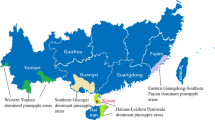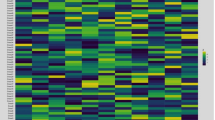Abstract
The cultivation and utilization of two Perilla crops were surveyed in Asia. Perilla frutescens var. frutescens is essentially an oil crop and is now widely cultivated in China and Korea. Its seeds are also used as a flavor for traditional foods in Japan, Korea, China and Nepal. In Korea, leaves of var. frutescens are used as a fresh vegetable and for making pickles. Whereas P. frutescens var. crispa is a Chinese medicine and afresh vegetable in the Far East, it has almost disappeared in many parts of Asia. Cultivation of var. crispa is still continued in Japan and Vietnam. In particular, it is cultivated in a large scale for coloring pickles in the areas where a large amount of plum pickles are produced in Japan. In China and Korea, it remains only as a relict form. Weedy plants ofPerilla are found in Japan, Korea and China. We can classify them into two forms; one, which is closely related to var. frutescens, and the other, which is similar to var. crispa We foundP citriodora andR hirtella in Guandong and Jiangxi provinces of China, respectively. It is clear that they are not endemic to Japan. A phylogenetic tree of samples of two Perilla crops and their weedy forms based on RAPD markers revealed that the weedy forms similar to var. crispa and var. frutescens are genetically closely related to var. crispa and var. frutescens, respectively. Var. crispa and its closely related weedy form seem to be more primitive.
Similar content being viewed by others
Literature Cited
Duke, J. A., and E. S. Ayensu. 1985. Medicinal plants of china. Reference Publ., Algonac, MI.
Felsenstein, J. 1985. Confidence limits on phylogeny: an approach using the bootstrap. Evolution 39:783–791.
—. 1993. PHYLIP, Phylogeny inference package, version 3.572. University of Washington, Seattle, WA.
Honda, G., Y. Koezuka, and M. Tabata. 1990. Genetic studies of color and hardness inPerilla frutescens. Japanese Journal of Breeding 40:469–474.
—,A. Yuba, T. Kojima, and M. Tabata. 1994. Chemotaxonomic and cytogenetic studies onPerilla frutescens var.citriodora (“Lemon Egoma”). Natural Medicine 48:185–190.
—,M. Ito, and M. Tabata. 1996. A new species ofPerilla (Labiatae) from Japan. Japanese Journal of Botany 71:39–43.
Ito, M., and G. Honda. 1996. A taxonomic study of Japanese wildPerilla (Labiatae). Journal of Phytogeography and Taxonomy 44:43–52.
Kasahara, Y. 1981. A finding method of plant seeds from Torihama kitchen midden andPerilla seeds in tar state. Reports of excavations from Torihama kitchen midden in 1980, 65–87. (In Japanese).
Li, H. L. 1969. The vegetables of ancient China. Economic Botany 23:235–260.
Li, X. W. 1974. Var.auriculato-dentata, some changes of scientific names in Chinese Labiatae. Acta Phytotaxonomica Sinica 12:228.
Makino, T. 1914.Perilla ocimoides Linn. Botanical Magazine 28:180.
—. 1926.Perilla frutescens (L.) Brit. α.typica Makino. Journal of Japanese Botany 3:7–8.
—. 1961. Makino’s new illustrated flora of Japan. Hokuryu-kan, Tokyo. (In Japanese).
Matsutani, A. 1983. Egoma-Shiso. Pages 50–62 in S. Katoh, T. Kobayashi, and T. Fujimoto, eds., Research on the Jomon culture vol. 2. Occupations. Yuzankaku, Tokyo. (In Japanese).
Nagai, I. 1935. On “Shiso” and “Egoma.” Agriculture and Horticulture 10:2265–2273. (In Japanese).
Nakai, T. 1917.Perilla hirtella Nakai. sp. nov. Botanical Magazine 31:285.
Nitta, M., and O. Ohnishi. 1999. Genetic relationships among twoPerilla crops, shiso and egoma, and the weedy type revealed by RAPD markers. Genes and Genetic Systems 74:43–48.
Perry, L. M. 1980. Medicinal plants of east and southeast Asia: attributed properties and uses. MIT Press, Cambridge, MA.
Saghai-Maroof, M. A., K. M. Soliman, R. A. Jorgensen, and A. W. Allard. 1984. Ribosomal DNA spacer-length polymorphisms in barley: Mendelian inheritance, chromosomal location, and population dynamics. Proceedings of the National Academy of Science 81:8014–8018.
Saitou, N., and M. Nei. 1987. The neighbor joining method: a new method for reconstructing phylogenetic trees. Molecular Biology and Evolution 4: 406–425.
Welsh, J., and M. McClelland. 1990. Fingerprinting genomes using PCR with arbitrary primers. Nucleic Acids Research 18:7213–7218.
Williams, J. G. K., A. R. Kubelik, K. J. Livak, J. A. Rafalski, and S. V. Tingey. 1990. DNA polymorphisms amplified by arbitrary primers are useful as genetic markers. Nucleic Acids Research 18: 6531–6535.
Yamane, Y. 1950. Cytogenetic studies inPerilla andColeus. I. Chromosome numbers. Japanese Journal of Genetics 25:220. (In Japanese).
Yu, K., and K. P. Pauls. 1992. Optimization of the PCR program for RAPD analysis. Nucleic Acids Research 20:2606.
Zeven, A. C., and J. M. J. de Wet. 1982. Dictionary of cultivated plants and their regions of diversity. Centre for Agricultural Publishing and Documentation, Wageningen.
Author information
Authors and Affiliations
Corresponding author
Rights and permissions
About this article
Cite this article
Nitta, M., Lee, J.K. & Ohnishi, O. AsianPerilla crops and their weedy forms: Their cultivation, utilization and genetic relationships. Econ Bot 57, 245–253 (2003). https://doi.org/10.1663/0013-0001(2003)057[0245:APCATW]2.0.CO;2
Received:
Accepted:
Issue Date:
DOI: https://doi.org/10.1663/0013-0001(2003)057[0245:APCATW]2.0.CO;2




